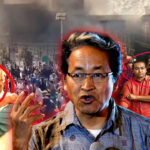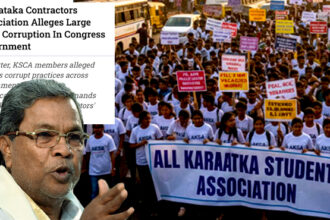In recent weeks, Indian social media platforms have been flooded with lakhs of posts, viral videos, hashtags, and even street protests under the banner “I Love Muhammad.” Loud chants, provocative slogans like “Sar Tan Se Juda” (beheading calls), and people waving these posters have turned what appeared to be a religious sentiment into a national-level political and social controversy.
But here’s the real question, was this truly a natural outpouring of emotion from the Muslim community, or was it a carefully orchestrated toolkit amplified by political players? Evidence increasingly suggests the latter.
How it all began
On September 4, 2025, in Kanpur’s Rawatpur area, a procession for Eid-e-Milad-un-Nabi (Prophet Muhammad’s birthday) was being carried out. A banner was displayed reading “I Love Muhammad.”
At the same time, a Hindu religious procession was passing through the same street. Reports confirm that during this overlap, some Muslim youths in the crowd tore Hindu posters with sticks, sparking a clash. The police intervened and filed FIRs against the rioters for disturbing communal harmony.
But instead of treating this as a localized law-and-order issue, a new narrative quickly emerged online — portraying the FIR as a conspiracy “against Muslims for saying I Love Muhammad.”
I Love Muhammad campaign
What began in Kanpur rapidly spread across Uttar Pradesh and beyond:
- Bahraich, Bareilly, Lucknow, Amethi, Unnao, Kaushambi, Maharajganj all witnessed similar protests.
- Facebook, Instagram, and Twitter saw #ILoveMuhammad trend nationwide.
- In Madhya Pradesh, stones were pelted at a Kali idol.
- In Gujarat’s Godhra, mobs surrounded a police station.
- In Uttarakhand’s Kashipur, police personnel themselves were beaten by protesters.
What was essentially a law-and-order matter in one city ballooned into a communal campaign across multiple states.
Political endorsements and amplification
The campaign gathered momentum once political parties started endorsing it. On September 20, the Congress Minority Department issued a statement saying its representatives had met those who faced FIRs for displaying the banners. Soon after, Congress leader Shama Mohammed publicly supported the slogan.
The Samajwadi Party also threw its weight behind the campaign. SP leader Abu Azmi declared that he was willing to go to jail for saying “I Love Muhammad.” Party spokesperson Amik Jamai claimed that whether it was “I Love Shri Ram” or “I Love Muhammad,” both fell under freedom of expression.
AIMIM chief Asaduddin Owaisi raised the rhetoric further, proclaiming that if saying “I Love Muhammad” was a crime, his community would accept every punishment. After his statement, violence escalated in Bareilly. Reports pointed to SP leader Nadeem Akhtar as a key figure in inciting unrest in Kashipur. AIMIM spokesperson Waris Pathan alleged that lakhs of Muslims were being unfairly booked for the slogan. Even Nagina MP Chandrashekhar Azad joined in, using the slogan in his speeches to directly challenge the police.
Women at the forefront: A familiar strategy
One of the most striking features of these protests was the involvement of women. In Lucknow, SP spokesperson Sumaiyya Rana — daughter of controversial poet Munawwar Rana — was seen leading demonstrations along with other women protestors. This echoed the tactics of the Shaheen Bagh protests during the CAA-NRC controversy, where women were placed at the frontlines to project an image of peaceful victimhood and generate sympathy. In reality, this too was part of a larger political strategy to soften the image of the movement while amplifying its impact.
The hidden truth
What much of the media and political voices failed to highlight was that the FIRs were not registered for displaying “I Love Muhammad” banners. They were filed because Hindu posters were vandalized, and new slogans were introduced in a way that inflamed communal tensions. In truth, the real victims of this episode were Hindus whose deities and posters were disrespected. Yet the story was flipped, portraying Muslims as victims of persecution. This deliberate distortion diverted attention from the original offense and allowed political forces to exploit the situation for their own gain.
Congress’s consistent double standards
The Congress party’s involvement in amplifying this narrative is neither new nor surprising. This is the same party that once floated the theory of “Hindu terror,” with reports suggesting Rahul Gandhi himself claimed Hindu organizations were more dangerous than Islamic terrorists. Today, the same leadership that promotes slogans like “Mohabbat ki Dukaan” is extending support to groups engaging in vandalism, violence, and attacks on the police, all under the cover of religious devotion.
Conclusion: A toolkit in the garb of religion
The “I Love Muhammad” movement was not a spontaneous show of faith. It was a carefully constructed campaign, designed to inflame passions, shift blame away from rioters, and create an image of victimhood for political mileage. By exploiting religious sentiments and twisting narratives, political parties, particularly the Congress and its allies, turned a local scuffle into a nationwide flashpoint.
This raises a fundamental question: how long will India’s peace and democracy be sacrificed at the altar of short-term electoral politics?






